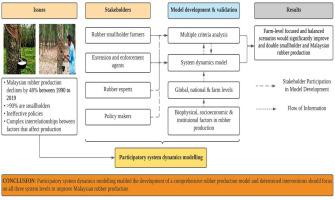Agricultural Systems ( IF 6.1 ) Pub Date : 2022-09-02 , DOI: 10.1016/j.agsy.2022.103491 Muhammad Fadzli Ali , Siti Hawa Sulong , Kotir Julius , Carl Smith , Ammar Abdul Aziz

|
CONTEXT
Increasing rubber price volatility has adversely affected smallholders – Malaysia's primary rubber producers' livelihood. This, in turn, has caused them to abandon rubber farming and led to the decline of Malaysian rubber production over the last few decades. In this paper, a rubber production model was developed using a participatory system dynamics modelling approach, involving multiple key rubber industry stakeholders.
OBJECTIVE
The study's objectives include: 1) to use the developed rubber production model to quantitatively assess the impact of interactions between key components of the rubber production system at the farm, national, and global levels on rubber production; and 2) to test the effectiveness of existing and proposed plausible policy and management scenarios to improve rubber production.
METHODS
We conducted structural, behavioural patterns, and statistical tests to evaluate and validate the performance of the developed model. We simulated key variables including smallholder and national productions, and farm-gate, national and global prices for a 30-year period. The model is set-up with time unit of years and time step of 0.25 years, using the Stella Architect software. Our analysis showed that the simulated outputs agreed well with the observed behaviour of the system. A sensitivity analysis indicated the model is reliable and robust to uncertainties in the major parameters. Five policy scenarios: (1) business as usual; (2) farm-level focused; (3) national-level focused; (4) global-level focused; and (5) balanced were simulated to assess their impact on smallholder and national production, smallholder net revenue, and global, national and farm-gate rubber prices.
RESULTS AND CONCLUSIONS
The results showed that the farm-level focused and balanced scenarios would significantly improve and double smallholder and Malaysian rubber production. Based on the scenarios analyses, Malaysian rubber production can be improved by (1) tightening rubber export restrictions at the global level; (2) increasing domestic rubber consumption and reducing rubber imports at the national level; (3) increasing rubber production incentive; (4) improving collaboration between agencies and increasing resources available to extension and enforcement agents, and rubber production incentive campaigns; and (5) finding additional income, through intercropping at the farm level for example.
SIGNIFICANCE
The model is flexible, and other rubber producing countries with similar features and environmental and socioeconomic conditions can adapt the system dynamics simulation model to understand and evaluate the impact of policies that can improve the livelihood of smallholders.
中文翻译:

使用参与式系统动力学建模方法为马来西亚橡胶生产管理提供信息
语境
橡胶价格波动加剧对小农(马来西亚主要橡胶生产商的生计)产生了不利影响。这反过来又导致他们放弃橡胶种植,并导致马来西亚橡胶产量在过去几十年中下降。在本文中,使用参与式系统动力学建模方法开发了一个橡胶生产模型,涉及多个关键的橡胶行业利益相关者。
客观的
该研究的目标包括:1) 使用已开发的橡胶生产模型来定量评估农场、国家和全球层面橡胶生产系统关键组成部分之间的相互作用对橡胶生产的影响;2) 测试现有和提议的合理政策和管理方案的有效性,以改善橡胶生产。
方法
我们进行了结构、行为模式和统计测试,以评估和验证开发模型的性能。我们模拟了 30 年期间的关键变量,包括小农和国家生产,以及农场出入口、国家和全球价格。该模型使用 Stella Architect 软件设置,时间单位为年,时间步长为 0.25 年。我们的分析表明,模拟输出与观察到的系统行为非常吻合。敏感性分析表明,该模型对主要参数的不确定性是可靠且稳健的。五种政策情景:(1)一切照旧;(2) 以农场为重点;(3) 国家级重点;(4) 聚焦全球;(5) 平衡模拟以评估其对小农和国家生产、小农净收入和全球的影响,
结果和结论
结果表明,农场层面的重点和平衡情景将显着提高小农和马来西亚的橡胶产量并使其翻一番。根据情景分析,马来西亚橡胶产量可以通过(1)在全球范围内收紧橡胶出口限制;(2)增加国内橡胶消费,减少国家层面的橡胶进口;(三)加大橡胶生产激励力度;(4) 改善机构之间的合作,增加推广和执法机构可用的资源,以及橡胶生产激励活动;(5) 寻找额外收入,例如通过在农场一级的间作。
意义
该模型具有灵活性,具有相似特征以及环境和社会经济条件的其他橡胶生产国可以采用系统动力学模拟模型来了解和评估能够改善小农生计的政策的影响。











































 京公网安备 11010802027423号
京公网安备 11010802027423号